SWEDISH SOUTH ASIAN STUDIES NETWORK
Nepal:
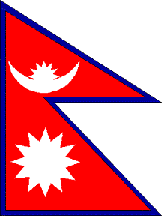 Official name: Federal Democratic Republic of Nepal
Official name: Federal Democratic Republic of Nepal
Area: 147 181 sq km.
Population: 27,070,366 (est. July
2004). Census in July 2001: 23,2 millions.
Approximately 96,500 refugees from Bhutan stay in Nepal, 90 p.c of whom
are in seven UNHCR camps.
Administrative divisions: 14 zones;
Bagmati, Bheri, Dhawalagiri, Gandaki, Janakpur, Karnali, Kosi, Lumbini,
Mahakali, Mechi, Narayani, Rapti, Sagarmatha and Seti.
Capital: Kathmandu
System of government: Republic since 28 May 2008, when political leaders in Nepal in the new constitutional assembly voted overwhelmingly to abolish the Himalayan nation's 240-year-old Hindu monarchy.
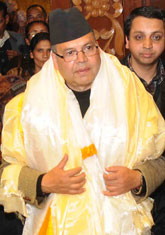 Prime Minister: Jhala Nath Khanal (photo), Communist Party of Nepal (Unified Marxist-Leninist) chairman. He was elected Nepal’s 34th Prime Minister by the Legislature Parliament on 3 February 2011, ending a six-month long status quo. In addition to his party UML and his largest supporter Unified CPN (Maoist), Rastriya Janamorcha, CPN (ML), CPN (ML-Samajwadi), Nepal Rastriya Party, Sadbhawana Party (Anandidevi), Rastriya Janmukti Party, Nepali Janata Dal and Sanghiya Loktantrik Rastriya Manch also supported Khanal. Nepal Majdoor Kisan Party lawmakers boycotted election process.
Prime Minister: Jhala Nath Khanal (photo), Communist Party of Nepal (Unified Marxist-Leninist) chairman. He was elected Nepal’s 34th Prime Minister by the Legislature Parliament on 3 February 2011, ending a six-month long status quo. In addition to his party UML and his largest supporter Unified CPN (Maoist), Rastriya Janamorcha, CPN (ML), CPN (ML-Samajwadi), Nepal Rastriya Party, Sadbhawana Party (Anandidevi), Rastriya Janmukti Party, Nepali Janata Dal and Sanghiya Loktantrik Rastriya Manch also supported Khanal. Nepal Majdoor Kisan Party lawmakers boycotted election process. On 14 Augsut 2011, Jhala Nath Khanal stepped down and resigned from office after the government and the opposition failed to agree on a new constitution after 10 years of civil war. More information.
President: On 23 July 2008, Ram Baran Yadav (Nepali Congress) was elected as the first President of Nepal.
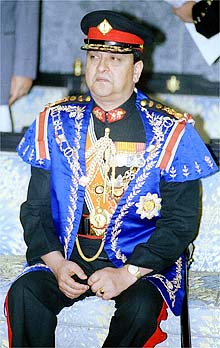 Former Head
of State: King Gyanendra Bir Bikram Shah (photo) was
coronated to become the new king of Nepal on June, 4, 2001, after a shocking
massacre on the Royal family inside the palace at Kathmandu three days
earlier.
Former Head
of State: King Gyanendra Bir Bikram Shah (photo) was
coronated to become the new king of Nepal on June, 4, 2001, after a shocking
massacre on the Royal family inside the palace at Kathmandu three days
earlier.
In the carnage king Birendra, who had ruled Nepal since 1972 was assasinated.
Crown prince Dipendra was also severely hurt at the event, but nonetheless
he was soon declared king after his father. Dipendra, though, also died
two days later and after that Gyanendra took over.
On May 29, 2008, the Constituent Assembly decided to abolish Nepal's monarchy, and two weeks later the deposed king left the royal palace in Kathmandu. He now lives as a commoner in the country.
Ethnic groups: The population is
divided into two broad ethnic groups, the Indo-Nepalese – which include
the Pahari, Newar, Tharu and the Indians of the Tarai (all of which account
for nearly 80 p.c of the population) and the Tibeto-Nepalese who account
for the remainder (including the more numerous Tamang, Rai, Limbu, Bhote,
Sunwar, Magar and Gurung tribes).
The Magars constitute the largest group of the nationalities. They constitute
7,2 p.c of the total population. In descending order, the Tharus follow
with 6,5 p.c, the Newars at 5,6 p.c, Tamangs with 5,5 p.c, Rais with 2,8
p.c, Gumngs at 2,4 p.c and Limbus at 1,6 p.c. The rest of the nationalities
are less than one percent. The Rautes have the least number among the
nationalities, numbering 2,878.
Religions: Hindus 86,2 p.c., Buddhists 7,8 p.c., Muslims
3,8 p.c., other religions 2,2 p.c.
Languages: Approximately 40 languages.
Nepali 50 p.c is the official language; Maithili 11 p.c; Bhojpuri 8 p.c;
Awadhi 5 p.c.
National anthem: ”Shreeman
Gambhir” (May Glory Crown Our Illustrious Sovereign”,
composed 1899 by Bakhatbir Budhapirthi. Text by Chakrapani Chalise. More
information .
National Calendar: The Nepali year
begins in mid-April and is divided into 12 months: Baisakh, Jestha, Asadh,
Shrawan, Bhadra, Aswin, Kartik, Marga, Poush, Phalgun, Chaitra. Saturday
is the official weekly holiday.
GDP per capita: Purchasing power
parity – 1.400 US-dollars (est 2003)
GDP by sector: Agriculture: 40 p.c,
Industry: 20 p.c, Services: 40 p.c (ets. 2002)
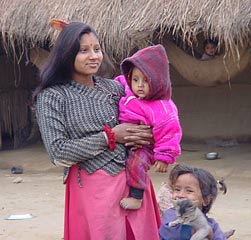 Population
below poverty line: 42 p.c (est 1995-96)
Population
below poverty line: 42 p.c (est 1995-96)
Economy: Agriculture provides a livelihood
for over 80 p.c of the population. Agricultural products: Corn, Barley,
Water Buffaloe meat, Fruit, Jute, Medicinal Herbs, Pepper, Potatoes, Rice,
Sugar Cane, Timber, Tobacco, Wheat.
Industries: Agriculture, Cement,
Cigarettes, Forestry, Garments, Jute Spinning, Sugar Milling, Textiles,
Tourism.
Exports: 568 million US-dollars (est. 2002), not including unrecorded border trade with India. Commodities: Carpets, clothing, leather goods, jute goods, rice, sugar, timber.
Administration: The Parliament has two legislative chambers – the House of
Representatives and the National Council (the upper house). The House
of Representatives consists of 205 members, popularly elected to five-year
terms. The 60 members of the National Council hold six-year terms; 10
are nominated by the king, 35 are elected by the House of Representatives
(of which three must be women), and 15 are selected by an electoral college.
The constitution of 1990 gives the House of Representatives considerably
more power than the National Council.
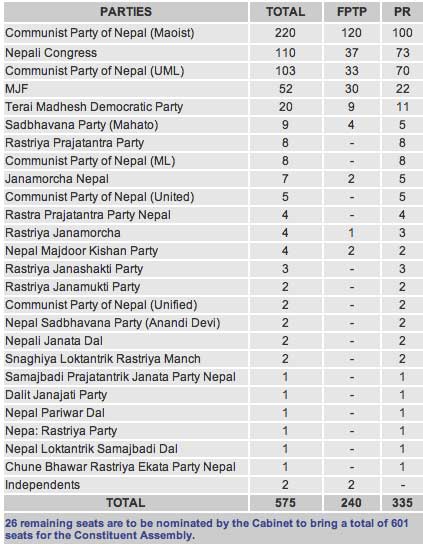 Political situation: The unexpected victory of the Maoist rebels in Nepal's elections on April 10, 2008, has surprised the former rebels themselves, baffled political observers and stunned the international community.
Political situation: The unexpected victory of the Maoist rebels in Nepal's elections on April 10, 2008, has surprised the former rebels themselves, baffled political observers and stunned the international community.
The general expectation was that the rebels would trail behind the country's two largest political parties, the Nepali Congress, and the mainstream-left, the Communist Party of Nepal-United Marxist Leninist.
But both the parties were left far behind the Maoists who won half the seats chosen by the first-past-the-post system and gained about 30% of the votes for seats given by proportional representation.
The full election results shown to the right (source: Nepalnews.com, May 4, 2008).
Other important political leaders:
Madhav Kumar Nepal, Sahana Pradham and Bam Dev Gautam, Communist Party of Nepal (Unified Marxist-Leninist) – CPN/UML
Gajendra Narayan Singh (NSP)
Pushpa Kamal Dahal (”Comrade” Prachanda) (CPN-Maoist) – Prime Minister 15 August 2008 – 4 May 2009., ![]()
Recent history: The World’s
only officially proclaimed Hindu kingdom was till the middle of the 18th
Centrury split into several princely states. But in 1768 the country was
united under the leadership of the gurkha king Prithvi Narayan Shah. During
the period1846-1951 the Nepalese kings were not in real control of the
country as the power had been taken over by the hereditary Prime minister
family of Rana, which held complete control of the government.
In 1950 King Tribhuvan began a plot to overthrow the Rana family and when
it was discovered, he fled to India. After which an armed revolt led by
the Nepali Congress began. The order was, though, quickly restored by
India. But in 1951 Bisweswore Prasad Koirala became the first non-Rana
Prime Minister for more than 100 years, in 1959 the first free elections
were held and a new constitution inaugurated.
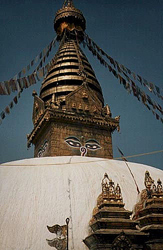 However,
in December 1960 King Mahendra banned all political parties and suspended
the constitution. In 1962 a new constitution was established which set
up a non-party council known as the Rashtriya Panchayat. In 1972 King
Mahendra died and was succeeded by Prince Birendra. In May 1980 a referendum
was held to give the people a choice between a reformed version of the
existing system or a multiparty based system, which resulted in the return
of the Rashtriya Panchayat.
However,
in December 1960 King Mahendra banned all political parties and suspended
the constitution. In 1962 a new constitution was established which set
up a non-party council known as the Rashtriya Panchayat. In 1972 King
Mahendra died and was succeeded by Prince Birendra. In May 1980 a referendum
was held to give the people a choice between a reformed version of the
existing system or a multiparty based system, which resulted in the return
of the Rashtriya Panchayat.
Following riots and demonstrations led by a popular movement for democracy
in 1990 the king finally was forced to announce a new constitution which
would allow for a multi-party system of government. The power of the king
was reduced. In May 1991 the Nepali Congress Party won general elections
and Girija Prasad Koirala was elected Prime Minister. During the 1990´s
the internal politics of Nepal has remained unstable, with a several succession
of new governments.
King Birendra was killed in a massacre on the Royal family at 1 June,
2001. His son, crown prince Dipendra, was declared nw king even though
he was also severely hurt. Dipendra died two days later, and was succeded
by his uncle, Birendras younger brother, Gyanendra.
Relations with Bhutan deteriorated in the beginning of the 90s
after allegations that the Nepalese government was supporting pro-democracy
activists there, and the stream of ethnic nepalese refugees. And inside
Nepal a Maoist guerrilla-based insurgency has in recent years plagued
the country.
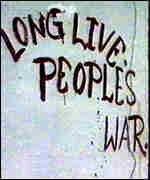 An
armed maoist-inspired rebellion is going on in large parts of the country
since the middle of the 1990s, by the Communist Party of Nepal (Maoist),
led by Pushpa Kamal Dahal (generally known as ”Comrade”
Prachanda) . The rebellion has its centre in the four western districts
of Rukum, Rolpa, Salyan and Jajarkot, but has spread all over the country.
An
armed maoist-inspired rebellion is going on in large parts of the country
since the middle of the 1990s, by the Communist Party of Nepal (Maoist),
led by Pushpa Kamal Dahal (generally known as ”Comrade”
Prachanda) . The rebellion has its centre in the four western districts
of Rukum, Rolpa, Salyan and Jajarkot, but has spread all over the country.
The government imposed a state of emergency in Nepal on 26 November, 2001,
after more than 100 people were killed in four days of violence. King
Gyanendra ordered for the first time the army to crush the rebels, which
the government now labels as terrorists.
The emergency has since elapsed, but the situation in the country continues
to be very tense. The rebels say that the war will continue until their
demands are met. These include formation of a an interim government; election
of a constituent assembly; and organizing the country as a democratic
republic.
On 24 April 2006, following a programme of nationwide political demonstrations
and street agitation since 6 April 2006 by the political parties and
the Maoists, the King announced the reinstatement of parliament. Following
the King’s announcement the political parties called off their
general strike. While the Maoists initially rejected the King’s
address, they subsequently called off their blockade of the main highways
pending the first session of the reinstated Parliament on 28 April 2006,
and an announcement of whether further of their demands will be met.
On 26 April 2006, they announced a three-month unilateral ceasefire.
Both sides agreed to a UN monitored permanent ceasefire. A peace agreement between the Government of Nepal and the Maoists was signed in Kathmandu on 21 November 2006 thereby ending 11 years of conflict in Nepal. The two sides agreed a permanent ceasefire, which is being monitored by the UN.
Following the largely peaceful elections on 10 April 2008, a Constituent Assembly was sworn in on 27 May. On 28 May the Constituent Assembly declared Nepal a republic. There were several bombs in Kathmandu in protest at the change to republicanism. In September, the new Maoist-led coalition government finally took office with an agenda to deliver change. On 4 May 2009 the Prime Minister announced his resignation, increasing political uncertainty.
Tensions between political parties in Nepal remain significant, with the potential for violent clashes or extremely disruptive strike action. These clashes have, in some cases, resulted in injuries and deaths of party activists and candidates. Recent political protests by ethnic and religious groups in the Terai and Eastern region have, resulted in localised violence and disruption. Equally, there are other interests groups who use similar tactics to pursue their objections. For example, in January 2008, there were widespread demonstrations in Kathmandu and a number of other cities against government increases in fuel prices. Many of these demonstrations became violent, with tyres burnt and vehicles, including those of foreigners, attacked. The situation in the Terai and Eastern region remains difficult, with political tensions over the region’s demand for significantly increased autonomy and serious problems in delivering law and order. There are a number of militant groups operating in the Terai, as well as the tensions between political parties found in other parts of the country.
More information by Wikipedia.
| More information on Nepal |
Wikipedia, the free encyclopedia, Nepal
Government of Nepal Directory.
Nepal – general data of the country, ”Populstat” website by Jan Lahmeyer, Utrecht University, Netherlands
BBC News Country Profile Nepal
The Human Development Report 2009 data on Nepal
UN Nepal Information Platform is the virtual home of the United Nations in Nepal. It contains lots of information on humanitarian and development issues, regularly updated with the latest news, studies, reports and assessments relevant to Nepal. The web site has been developed and maintained by OCHA, the UN Office for the Coordination of Humanitarian Affairs.
The Library of Congress, USA, offers through its Country Studies Web site detailed Information on all Aspects of Countries round the Globe. Look for Nepal. Information contained in the Country Studies On-Line is not copyrighted and thus is available for free and unrestricted use by researchers. As a courtesy, however, appropriate credit should be given to the series. Unfortunately, though, the information on Nepal is not updated since September 1991.
World Bank Group/Nepal: Data reports, statistics, projects etc, for Nepal
CIA – The World Factbook: Nepal
Nepal Research – a website on Nepal and Himalayan Studies by Lhakpa Doma Salaka-Pinasa Sherpa and Karl-Heinz Kraemer
Timeline Nepal. Chronological historical facts on Nepal, by BBC South Asia
The British Foreign & Commonwealth Office (FCO) advice on safety aspects on travelling to Nepal

The Swedish Government’s Division for Democratic Issues, based at the Ministry of Justice, regularly publishes reports about the human rights situation in countries all over the World. Read the 2007 Report on the Human Rights Situation in Nepal (in Swedish only).
SASNET - Swedish South Asian Studies Network/Lund
University
Address: Scheelevägen 15 D, SE-223 70 Lund, Sweden
Phone: +46 46 222 73 40
Webmaster: Lars Eklund
Last updated
2011-08-15
